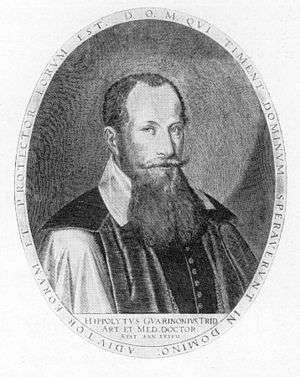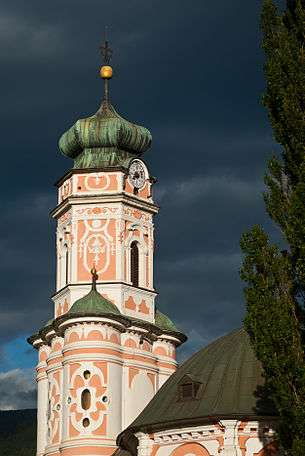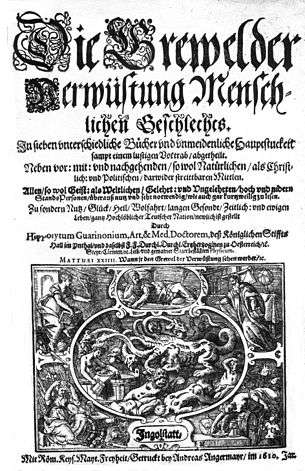Hippolytus Guarinonius
Hippolytus Guarinonius (18 November 1571 – 31 May 1654) was a physician and polymath who spent the main part of his life based at Hall in Tirol.[1] He represented a militant strand of Catholicism and was instrumental in the building of the St Charles Church (Karlskirche) in Volders. He was also an instigator of the Andreas Oxner Anti-semitism cult.
Hippolytus Guarinonius Hippolyt Guarinoni / Ippolito Guarinoni | |
|---|---|
 | |
| Born | 18 November 1571 |
| Died | 31 May 1654 |
| Occupation | Physician, counter reformation activist |
| Spouse(s) | Charitas Thaler (1599) Helena von Spieß (1613) |
| Children | 10 |
Life
Guarinonius was born in Trent, then a powerful bishopric. His father, Bartolomeo Guearinius, the son of a physician and the grandson of a goldsmith, was called away to Vienna soon after the boy's birth, to take up a post as a physician at the court of Emperor Maximillian II.[2] The mother of Guaronius, Catharina Pellegrini, came from an established Trent family, but due to family opposition his parents, though married, were not married to each other, which made Hippolytus Guarinonius illegitimate.[2] Issues regarding his birth status would be retrospectively resolved in 1618, however, when Pope Paul V declared that his parents had been married to each other. Despite reports to the contrary,[3] Hippolytus Guarinonius himself later recorded that he spent the first eleven years of his life growing up in Vienna till his father relocated to Prague in 1583, still a court physician, but now working for a new emperor, Rudolf II.[2]
In Prague Guarinonius received an intensive and formative education as one of approximately 150 boarders at the Jesuit Gymnasium (secondary school).[2] Between 1593 and 1597 he studied Medicine at the University of Padua, where he qualified as a doctor in 1598.[4] Directly following his studies he may have worked as a doctor in Trent (sources differ) but in or before 1601 he relocated to Hall in Tirol,[4] then an important administrative city in the Habsburg territories, some 180 km (110 miles) to the north of Trent. One of his early appointments at Hall in Tirol came in 1601 when he was appointed Municipal Physician, which was a public appointment.[4] In 1607 he was appointed de:Leibarztpersonal physician to the Archducesses Eleanor and Archduchess Maria Christina of Austria, Habsburg siblings who had retreated to a monastic existence in the town following the disastrous marriage of one of them.[3]
In 1611–12 the town was hit by plague (probably bacterial typhus) and Guarinonius moved out of the town centre,[4] but he encouraged the construction of medical huts where plague victims could be accommodated in slightly more sanitary conditions, paying particular attention to preventive measures, attending to the operation of the mineral springs and encouraging physical health and exercise. He also coined the phrase, "Achtung auf die Natur und zurück zu ihr, Maßhalten in jedem!"[5][6]
A singular passion for Guarinonius was the strengthening and updating of Catholicism. This won him plaudits in conservative circles but also made him a controversial figure for the town council and for other fellow citizens, some of whom founds Guarinonius an unscrupulous tactician. Sometimes his fanaticism was too much even for his Jesuit mentors. In 1611 his behaviour was robustly denounced[7] to the Archduke by the Bolzano theosophist, Adam Haslmayr. Haslmayr's intemperate outburst earned him a punishing stretch as a Genoa galley slave, although he survived the experience.[8]

(photograph Hermann Hammer)

(Ingolstadt, 1610)
From 1620 till his death Guarinonius directed the construction of the St Charles Church (Karlskirche) in Volders, which was built according to his own design.[9] He was also responsible for the construction of several other religious buildings. At the same time, Guarinonius continued to publish medical and religious texts during this period.[4]
In 1628 he was authorized by Daniel Zeno, the Bishop of Brixen, to "catechize" in the mountain villages as a Catholic lay preacher (Laientheologe). He thus became what he himself termed a "secular Jesuit" ("weltlicher Jesuiter"). He interpreted his role not merely as that of a preacher of morality and discipline, but as a one-man vice-squad. Everywhere he looked he saw frivolity and "beastliness" ("Lüderlichkeit"). His condemnations were unrelentingly harsh.
Possibly because of his strenuous efforts for the public good, the Emperor Ferdinand II appointed him to an honorific court medical post (Erzarzt von und zu Hoffberg und Volderthurn), while the pope made him a Vatican Knight of the Golden Spur.
Family
Hippolytus Guarinonius was married twice. His first wife, Charitas Thaler, bore him eight children, including one set of triplets who died shortly after their births, and underwent an emergency baptism in which each received the name, Christina followed by one of the virtues identified in Verse 13, Chapter 13 of the Apostle's First Epistle to the Corinthians (Christina Fides, Christina Spes and Christina Charitas). Two years after the death, in 1610, of his first wife he married again. His second wife, Helena von Spieß, bore him two further sons.
Another source states merely that he had many children, most of whom died young.[10]
The Architect and Master Builder
The St Charles Church (Karlskirche) in Volders represents a dramatic physical manifestation of Guarinonius's religious zeal. It was constructed according to his own plans, and is today easily accessible from the motorway service area on the Inn Valley Autobahn (direction Kufstein).[11] The church, built in the style sometimes described as "Venetian Baroque", exhibits an almost oriental flamboyance: it is one of the most important sacred buildings in what remains of the Austrian Tirol. The floor-plan of the building is modelled on that of St. Peter's in Rome. Guarinonius funded the church's construction from his personal wealth, and progress was frequently interrupted when the money ran out. It was completed only on 25 July 1654, more than 34 years after the placing of the foundation stone on 2 April 1620.[12]
Guaronini died on 31 May 1654, on Trinity Sunday. He is buried in "his" Karlskirche in Volders.
The inscription on his grave reads as follows:
- ECCE VIATOR
- ORBI FAMOSUS IN ARTE VIRTUTE DOCTRINA PIETATE ET NOBILITATE PRAECLARUS MEDICUS HIPPOLYTUS QUARINONIUS AB HOFFPERG ET FOLDERTHURN TRIDENTINUS HUJUSCE PRAESENTIS ECCLESIAE FUNDATOR ET EXTRUCTOR DEFUNCTUS ULTIMO DIE MAII ANNO MDCLIV JACET HIC QUI UT CUM ADIACENTE DELECTA CONIUGE SUA HELENA TOTAVE SUA FAMILIA GAUDETA AETERNA DEUM TER OPT MAX APPRECARE
Passer by, see here
The world famous Hippolytus Guarinonius, known for his virtue, doctrinal piety and nobility, physician to the Imperial Court and the Volders district, died on the final day of May 1754 and lies here beside his wife, ready to rejoice with the wider family in Christ in praise for the everlasting God
He died at the end of May 1654, soon after the completion of the church, and two months before its formal consecration He was himself buried at the Karlskirche, where his body lies beneath a marble slab before the steps of the "Epiphany alter", together with that of his wife and two of his sons.
Guarinonius also instigated the building of the Stiftsalm Chapel[13] in Voldertal and the Borgia Chapel in Volderwald (Tulfes). The chapel at the Volderer Wildbad has burned down several ties, and the present structure therefore only goes back to Guarinonius indirectly.
On the far side of the Inn Valley, the plans for the little church dedicated to St Anna in Baumkirchen were probably also drawn up by Guarinonius.[14]
The Writer
Guarinonius contribution as a writer on medical and religious topics is seen by some as even more notable than his architecture and building work.
His most important written work, of which the initial volume was published in Ingolstadt in 1610, was entitled "Die Grewel der Verwüstung menschlichen Geschlechts",[15] a seven volume work which, by its content and structure, defies any simple classification. Topics include doctors and apothecaries, the ducking of women, digestion, mountains and plains, eaters and stuffers, Engadine comedies, calendar discrepancies, anecdotes about Eulenspiegel, foxes' tails, fencing schools. Other subjects are German dog laws, how Jews and heretics love to devour meat, praise for older women, a peon of praise for guardians, rubbish and associated crime, the nature of geese and women, noodles and polenta eaten by peasants, and much more. Though its subject selection and format may appear haphazard, the "Grewel" is nevertheless a treasure trove for German philology and vernacular. It is particularly valued by scholars for insights it provides into unknown regional idioms and provincial colloquial expressions hitherto not traced to any form of written source. It is rich in allusions to contemporary German-language proverbs, speech patterns and word-play.
Of all his medical publications, "Pestilentz Guardien" (Plague recommendations),[16] which was published following two years of an epidemic locally, became particularly widely known. This "minor treatise" like the "Grewel" before it, appeared in seven volumes. These are entitled as follows:
- Recommendations for healthy people (" Guardi für den gesunden Menschen")
- Recommendations for priests, nurses and grave diggers ("... für Priester, Krankenwärter und Todtengräber")
- Recommendations for infected homes ("... für die infizierten Häuser")
- Recommendations for cemeteries ("... für die Friedhöfe")
- Recommendations for clothing and bedding ("... für Kleider und Wäsche")
- Recommendations against diverse errors ("... gegen verschiedene Irrtümer")
- Recommendations for people suffering salt and brine burn injuries ("... für Leute, die von der „Salzsur“ (Salzlauge) geschädigt und verbrannt wurden")
Also worth mentioning are his botanical publications that include "Hydrooeconomgania"[17] and "Chylosophiae academicae artis Aesculapiae novis astris illustratae tomi duo" which appeared respectively in 1640 and 1648.[18]
The Botanist
A herbarium assembled by Guarinonius was gifted by the Wilten Foundation to the Tyrolean State Museum in 1876. It is one of the earliest collections of this nature in central Europe. Compiled between 1610 and 1630, it comprises a book format herbarium with wooden covers and bevelled edges. It starts with a 13-page Latin/German index, which is followed by 106 pages incorporating 633 pressed and dried plant parts, originally collected in the Innsbruck area. [19]
References
- Jakob Franck (1879). "Guarinonius: Hippolitus G., Arzt und medicinischer Schriftsteller zu Anfang des 17..." Allgemeine Deutsche Biographie. Historische Kommission bei der Bayerischen Akademie der Wissenschaften. pp. 83–85.
- M.A.Katritzky (2012). "3". Hippolytus Guarinonius (1571-1654). Healing, Performance and Ceremony in the Writings of Three Early Modern Physicians: Hippolytus Guarinonius and the brothers Felix and Thomas Platter. Ashgate Publishing Limited, Farnham Sy & Burlington VT. pp. 29–47. ISBN 978-0-7546-6707-0.
- Otto Brandis (1910). "Guarinonius: Hippolitus G., Arzt und medicinischer Schriftsteller zu Anfang des 17....Zusätze und Berichtigungen (subsequent additions and corrections)". Allgemeine Deutsche Biographie. Historische Kommission bei der Bayerischen Akademie der Wissenschaften. p. 889.
- Verena Konrad (author); Petr Fidler (project team leader) (2009). "GUARINONI, Hippolyt ..... Baumeister, Arzt und Hygieniker, Schriftsteller und Universalgelehrter". Artisti Italiani in Austria. Retrieved 5 November 2015.
- "Achtung auf die Natur und zurück zu ihr, Maßhalten in jedem!"
(loosely: "Watch out for Nature and respect her: Moderation in all things!"). - Josef Hirn: Erzherzog Maximilian der Deutschmeister, Innsbruck 1915/36, p. 459.
- „Mein Gott, was hebt der guete Dr. Guarinoni nit an! Wäre wol besser, er bliebe bey seiner Fakultät!"
- Hannes Obermair: Frühes Wissen. Auf der Suche nach vormodernen Wissensformen in Bozen und Tirol. In: Hans Karl Peterlini (Ed.): Universitas Est. Bd. I: Essays zur Bildungsgeschichte in Tirol/Südtirol vom Mittelalter bis zur Freien Universität Bozen. Bozen: Bozen/Bolzano University Press 2008, pp. 35–87 (notably 44–47)
- "Dr. Guarinoni Hippolytus: Tirols berühmte Arzt, Architekt und Erbauer". This source states that Guaraninonius spent his youth as a page at the court of the Milan bishop, Carlo Borromeo, an assertion that seems to have originated with Borromeo himself. Note that several of the other sources also cited herein (though mostly, alas, not accessible in English) dismiss the assertion as "discredited", however. Tirol Guide. Retrieved 5 November 2015.
- Franz Grass (1966). "Guarinonius, Hippolytus: Förderer der Volksgesundheit, Volksschriftsteller, * 18.11.1571 Trient, † 31.5.1654 Hall (Tirol). (katholisch)". Neue Deutsche Biographie. Bayerische Staatsbibliothek, München. p. 247. Retrieved 5 November 2015.
- Mag. Anton Prock ("Für den Inhalt verantwortlich"). "Die Kirche liegt bei Volders zwischen Hall in Tirol im Westen und Wattens im ..." Die Karlskirche bei Volders feiert im Jahre 2004 ihren 350. Geburtstag - Grund genug zum Feiern. Archived from the original on October 26, 2004. Retrieved 5 November 2015.
- Mag. Anton Prock ("Für den Inhalt verantwortlich"). "Der Bau der Kirche und des Klosters sind ..." Die Karlskirche bei Volders feiert im Jahre 2004 ihren 350. Geburtstag - Grund genug zum Feiern. Archived from the original on October 26, 2004. Retrieved 5 November 2015.
- The Stiftsalm is a mountain
- "Ein Dorf in Tirol". Gemeinde Baumkirchen. Retrieved 5 November 2015.
- Die Grewel der Verwüstung menschlichen Geschlechts. Angermayr, Ingolstadt (1610 version) and Bayerische Staatsbibliothek, München (digital version).
- Pestilentz Guardien, Für allerley Stands Personen : mit Säuberung der inficierten Häuser, Beth-Leingewandt, Kleider, [et]c. Durch drey sonders außerlesneste Pest Waffen, darunder derwahre Philosophische Stein ... Angermayr, Ingolstadt (1612 version) and Bayerische Staatsbibliothek, München (digital version).
- "Hippolytus Guarinoni: Arzt, Schriftsteller, Architekt und Universalgelehrter". Quellen: Gertrud Pfaundler-Spat, Tirol-Lexikon, Innsbruck. Mag. Wolfgang Morscher iA Universität Innsbruck. 2005. p. 153. Retrieved 6 November 2015.
- Guarinonius, Hippolytus (1648). Chylosophiae academicae artis Aesculapiae novis astris illustratae tomi duo (in Latin). University of Innsbruck, Austria.
- Dr. Gerhard Tarmann iA der Naturwissenschaftlichen Sammlungen. "Flora und Fauna des Alpenraumes - Spezialsammlungen und Dokumentationszentrum". Naturwissenschaftliche Sammlungen. Tiroler Landesmuseum Ferdinandeum, Innsbruck. Retrieved 6 November 2015.